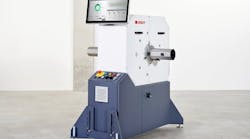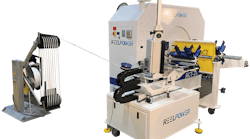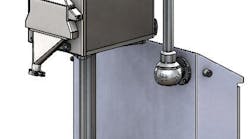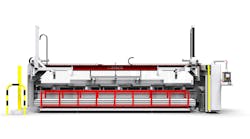By Anna Rajkovic
Market and innovation manager, Mechanical Recycling
Nova Chemicals
The flexible film market is predicted to continue a steady trend of growth, thanks to its versatility in a wide variety of markets, including the packaging, electronics, automotive and health-care sectors. Films offer many benefits in packaging design, enabling lighter structures that use less material, reducing emissions from transportation and providing convenient functionality for consumers.
Despite these advantages, the sustainable benefits of films are hampered by low recycling rates. Research from The Recycling Partnership found only 1 percent of Americans have access to curbside recycling for plastic films. Most collection of post-consumer films is through store drop-off locations, but the sheer variety in composition of flexible packaging makes them difficult or impossible to sort at traditional materials-recovery facilities.
To change the way the world uses plastics and drive the transition to a more circular economy, suppliers, processors and brand owners must work together to improve the collection and recycling of flexible films and incorporate post-consumer recycled (PCR) material into new applications.
Flexible packaging trends
The latest trends in packaging design focus on finding sustainable alternatives to non-recyclable materials and formats. As companies set ambitious emissions and waste-reduction goals, designing for recyclability has become a priority.
To achieve the desired combination of durability and moisture barrier properties, many types of flexible packaging have traditionally relied on multiple layers of films and laminates, including PE, PP, PET, paper and/or aluminum that cannot be separated and render the structure unrecyclable.
Suppliers and manufacturers are moving toward mono-material structures to create packaging that meets performance requirements but also is easier to recycle. Advancements in materials and equipment technologies are enabling all-PE packaging that can replace films with layers of biaxially oriented PP (BOPP) or PET in high-quality applications.
For example, Nova Chemicals has developed the first biaxially oriented high-density polyethylene (BOPE-HD) resin designed to run on commercial tenter frame lines. When paired with the company’s ASTUTE PE sealants, the resulting all-PE structure is fully recyclable and offers toughness and optical improvements over blown and cast films.
PCR considerations
Films that are designed for recyclability help strengthen the availability of consistent and clean feedstock for PCR materials, and ultimately provide companies with more sustainably sourced packaging options. While consumer preferences and legislative requirements are increasing the demand for PCR content, reliable sources of recycled resins do not yet exist for all applications, and high-value feedstock continues to find its way to the landfill. It will take a commitment to zero-waste, as well as end markets for PCR, to ensure that these potential feedstocks get collected and utilized in new applications.
Due to brand-owner and retailer commitments, significant demand for PCR exists in food-contact applications, but this material can be difficult to source due to strict safety regulations regarding possible contaminants. The U.S. Food and Drug Administration (FDA) does not approve materials for food packaging, but it issues letters of non-objection (LNO) to producers whose products and processes satisfy the FDA’s requirements.
One universal FDA requirement is that a recycler must be able to provide a documented chain of custody to show that the recycled material is made from packaging that was previously suitable for food-contact applications. Furthermore, based on the equipment being used and its efficacy, the FDA will grant conditions of use under which the material can be utilized — the broader the conditions of use, the more efficacious the process is in removing potential contaminants.
Receiving the LNO approval is only the first step in achieving PCR suitable for food-contact applications; manufacturers must continue to abide by the LNO terms and deliver a high-quality product each and every batch.
Value chain collaboration
Expanding the adoption of PCR materials into premium film applications like food packaging requires coordination across the value chain. Suppliers, processors, brand owners and retailers can build systems that maximize value and reduce waste by both implementing film collection programs and developing new products out of recycled film waste.
Opportunities abound for partnerships and collaborations. Resin suppliers are working with equipment manufacturers to facilitate sustainable material production. One example is Brückner Maschinenbau’s hybrid BOPP and BOPE lines, on which companies can run either material at different times. The lines can help companies transition to all-PE recyclable packaging designs. Joint development efforts can accelerate the commercialization of new technology and establish consistent demand for producers.
Some companies are partnering with recyclers or investing in their own facilities to build a more robust recycling infrastructure. Nova is taking both approaches. Research focused on recycling technology also is important, including sorting and cleaning for mechanical recycling and improved processes for advanced recycling.
Plastic films have transformed the industry with their flexible, durable and lightweight properties. Now it is time to rethink what happens to plastic film waste. Constructing a closed-loop process begins with increasing recycling rates and includes developing end markets that will use recycled content in new applications. Films and flexible packaging are essential to the plastics circular economy. With continued innovation and collaboration, they can become both recyclable and recycled — a truly sustainable choice for packaging that benefits companies, consumers and the environment.
Anna Rajkovic is the market and innovation manager for mechanical recycling at Nova Chemicals, responsible for the company’s PCR product portfolio, and driving circularity with plastic converter customers and across the entire plastics value chain. Anna joined Nova Chemicals in 2008; prior to her current role, she was an applications development specialist in the circular economy space, as well as a technical service specialist for the drums and pipe markets. She has also been deeply involved with industry associations, serving on the Association of Plastics Recyclers Film Technical Committee, and representing Nova Chemicals at Alliance to End Plastic Waste, Industrial Packaging Alliance of North America (IPANA), Rigid Intermediate Bulk Container Association, Packaging Distributors of America (PDA), Plastics Pipe Institute (PPI), ASTM International and the CSA Group, dedicated to supporting the circularity and recycling of plastics in Canada. Prior to joining Nova Chemicals, Anna was a regional sales manager at KWH Pipe in Calgary. Anna has a bachelor’s degree in chemical engineering from McMaster University in Hamilton, Ontario.







